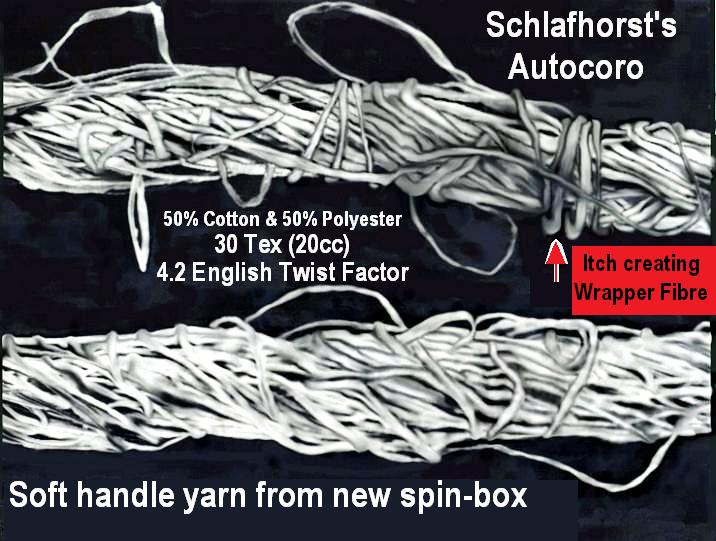SPINNING METHODS DISCUSSED
OE SPUN YARNS - VS RING SPUN YARNS - COMPARISONS ( PART 2 )
Further to our publication on Linkedin we would like to let our readers know more about insights and further developments concerning spinning technologies, in particular to a revolutionary development in OE spinning - and the application and trial of a new spinbox.
Quote :
On Tue, Jan 29, 2013 at 5:02 PM, we wrote:
Dear Mr. Parker
We appreciate your comments
and elaborations in your email given.
May we take this opportunity
to comment on our LinkedIn group : Textiles Engineering group :
http://www.linkedin.com/
Thanking you
sincerely
Heinz
Rainer
africasiaeuro.com

All
statements made by above are relative. No warranty as to
authenticity can be made. In addition some discrepancies are noted,
which will be discussed..
In respionse to :
1)
Rotorshafts are supposedly longer than hitherto applied ones. This
could have several reasons, I am not sure to which model of Autocoro
the writer refers to. In case of Tangetial belt drives, a longer shaft
will have better heat dissipation due to extended cooling surface.
Higher speeds are directly proportional to higher deliveries - and as
such require higher Rotor rotation, thus a longer shaft will dissipate
heat faster. This seems the only plausible reason. If on the other hand
a wider Rotor is used - a hypothesis , then a longer shaft will mean
underlying supporting discs are wider in diameter (a pre requisite at
higher Rotorspeeds due to higher gravity forces.
If on the other
hand Aero bearings are in use - or other than roller bearings with
supporting discs, in such case a longer rotorshaft will have more mass
- and as such requires more kinetic energy amounting in higher
energy consumption. It is not clear which type of bearing / Rotor /
supporting disc , and axial bearing is used here. In comparison Rieter
has been successfully applying their Aero bearings for well over a
decade now.
Without clear defintion no final explanation can be given.
Disclaimer : No Warranties provided. The
aforementioned yarn spinning technology is not officially known, nor do
we have any liason with persons who are mentioned. We can not accept
responsibility as
to authenticity. The name Schlafhorst
Autocoro is a registered Trademark.
Illustration shows
microscopic photography of OE yarnswith significant yarn wrappers in
first picture, and missing in second picture. we can not verify the
source and authenticity of these pictures.
2)
Correct is : Higher curcumferential speeds of rotors compact yarns and
at 120- 130000 RPM this can become a problem. The question is : In
order to achive significant delivery speed increase one must apply
higher rotational speeds in case of OE spun yarn. This is so far
the only possibility to reach a higher production rate on OE. In finer
counts the number of fibers in the crossection in the yarn are a
parameter which can not be overlooked. In order to maintain the minimum
number of fibers in the crossection attention on rawmaterial is
paramount.
In case of PES fibers higher rotorspeeds will
pose a problem of thermofixing if rotors are overheated due to friction
of tangential belts or axial bearings. If PES fibers are blended with
Cotton the natural wax content (oil) will create a barrier and
lubricant to aid spinning at higher speed to a certain degree.
OE
spun yarns do have a significant characteristic which manifest in form
of wrapper fibers. On the attached miscroscopic photography such
wrapper fibers are non visible. This is a phenomen which has to be
closer investigated. The structure on picture 2 show a clear
disctincton from picture 1. Fibers seem more parallel. Wrappers
are almost absent.
We shall continue to follow developments
and our efforts will include observations and opinions from machinery
manufactuers in this sector.
africasiaeuro.com



